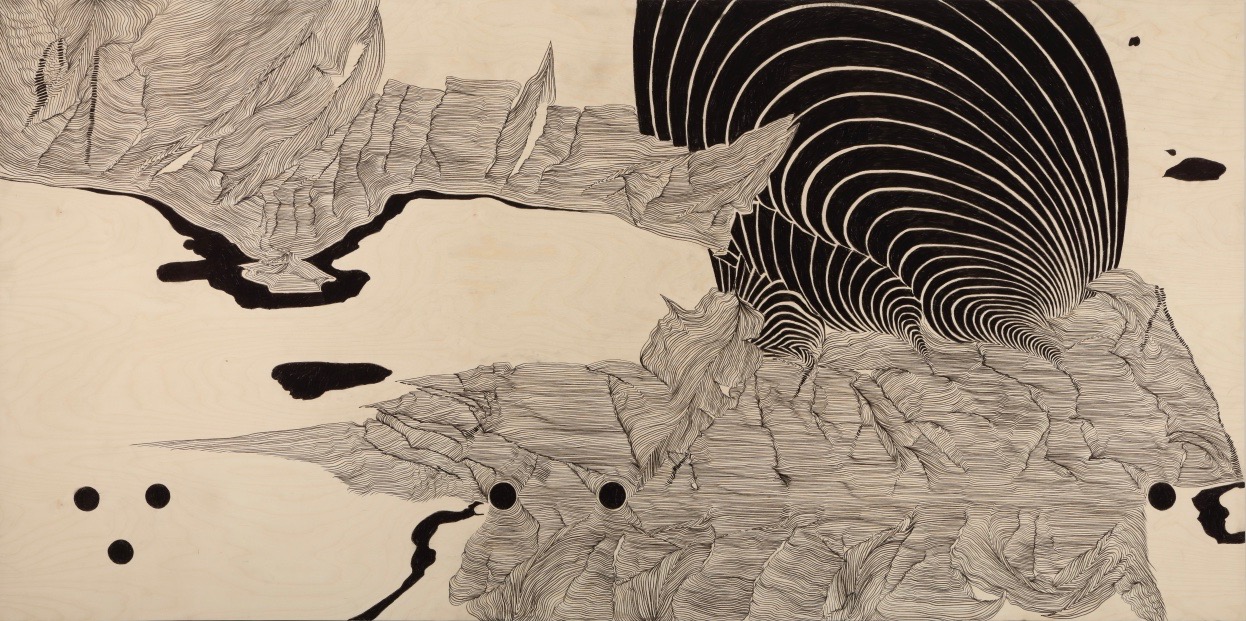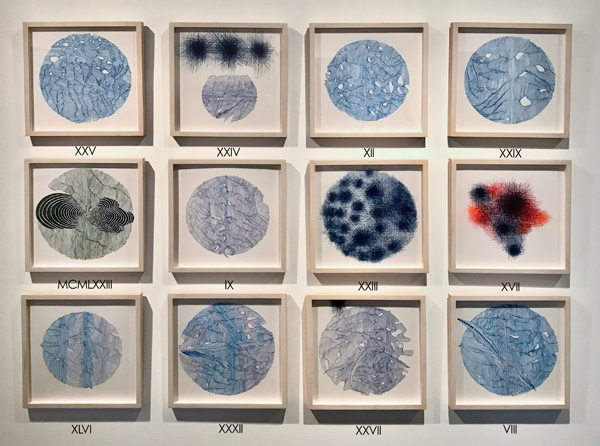
Atlanta artist Craig Dongoski explores the possibility of line in his show “Kissing the Gods,” on view at Whitespace Gallery through March 24. Using both ink and oil pencil on paper and wood panel, Dongoski creates images full of texture and pattern, all achieved with 2-D techniques.
Scattered throughout the show are rocks, a gong, wood slabs, and mysterious musical instruments. Low melodic vibrations playing on speakers conceptually glue all the elements together, but the opaqueness of his ideas in the artist statement make it challenging for most viewers to appreciate the work as anything more than formally pleasing.
Time is of the essence in these drawings. The curving lines resemble geological formations created over millennia. There’s a heady quality to Dongoski’s artistic aura, as spelled out in one of those statements that only make sense when you’re tripping balls. “I am exploring cupule-making as means to circumvent the ego and expose gestural portals toward deep time within the Lithosphere.” I take this to mean that in addition to his exploration of time, there exists a surreal quality to Dongoski’s vision — a lovely acid trip of flowing universal line over infinite time. He creates this quality by overlaying contrasting design elements that have temporal associations, as with the images that suggest geological formations that took millennia to create. Some of his line work results in a circular whole, which suggests the rings of a tree trunk formed over centuries. In a few of the works, the lines are determined by the traced wood grain of the panels.

In the wood pieces, Dongoski also adds some text between the wood grain and his line. In Double Spiral: I Can’t Seem to Make Your Mind, Dongoski uses a middle layer of ink that creates a bull’s eye, which plays a very modern, technological edge to contrast the organic line done in oil pencil. In And the Deities Lost Face the middle layer of ink looks like mold, which seems to degrade the quality of Dongoski’s line. In both cases, time is either pushed forward or pulled back by these imprinted elements.
The series WINTER, SPRING, SUMMER, AUTUMN features some of Dongoski’s best mark-making. The lines are executed with a fine-tip ink pen, allowing for infinitesimally more lines that no doubt required a steady, skilled hand. Most of the lines are a pleasing blue, though some feature green, brown, red, and black lines that are interspersed just enough to heighten visual interest without being garish.
By contrast, The Kissing of Gods features chunkier lines and some very thick layers of marks that suit the work’s larger scale. Sometimes Dongoski piles up the lines, furiously scribbling in loops and lines so much that they form a basket-woven dark mirror.

Curiously, Dongoski’s most interesting works aren’t in the main gallery but in the adjacent whitespec project space. The sketches here use a variety of lines. Of course, there’s the organic, geographic line familiar from the main gallery, but there are also cross hatches, dots, and something I call “space age marks”—combinations of dashes, dots, and circles—because they resemble mid-century modern design. Dongoski changes the angle of the dashes, the size of the circles, and the density of the dots to make drawings that seem to warp in and out of space. This style is, by far, Dongoski’s most compelling use of line. Together, the two styles—lines evoking the passage of time and these space age marks—evoke both the past and the future. And if you begin to feel lost within the time and space of this exhibition, return your mind to the ever present hum provided by the speakers, a sort of universal vibration that is grounded in the present.




